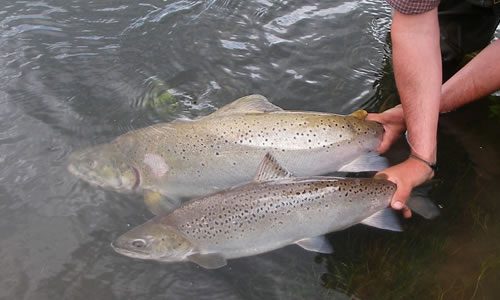By John Hickey, SAMARCH Policy Officer, WildFish
Populations of wild Atlantic salmon and sea trout have declined dramatically in the last two decades. Multiple freshwater factors have been associated with this trend, along with a very marked decline in marine survival.
To unravel the cause of this decline the SAlmonid MAnagement Round the Channel (SAMARCH) project (2017 – 2023) has collected evidence by studying salmon and sea trout on monitored rivers in Southern England and Northern France. With the data the partners have developed tools as well as informed management and policy guidance to better protect wild salmon and sea trout in coastal and transitional waters. Estuaries are known to be sensitive transitional areas for migratory fish, where they will often pause to acclimatise to changes in water flow and salinity.
The results of the project – which comprise six-years of work – were presented at a conference in Southampton earlier this month.
For further detailed information including reports and academic papers please explore the SAMARCH website.
Project delivery and outcomes
The work done by SAMARCH has supported a better understanding of salmonid migration and behaviour through four estuaries, for salmon smolts, sea trout smolts and sea trout kelts (post spawning fish). It has also:
- Recorded changes in the age and growth rates of salmon at sea.
- Updated information on the sex ratios of wild Atlantic salmon.
- Developed a new method for estimating salmon exploitation rates by anglers.
- Improved salmon lifecycle models.
- Developed a genetic baseline to identify the origin of sea trout caught at sea around the Channel area, as well as map areas that are important for sea trout survival, such as migratory routes and feeding hotspots.
Project Observations
The project which concludes this year makes the following observations:
- Timing and environmental conditions influence migration of salmon and sea trout in the four estuaries studied.
- Migratory behaviour differs between salmon and sea trout.
- Survival rate is higher in natural estuaries and lower when smolts swim for longer e.g. when they are presented with a barrier to migration such as a weir, dam or tidal barrage or when swimming in wide complex estuaries without a unique swimming direction.
- Estuaries present a challenge to migratory salmon and sea trout during migration. Fast migration speed through estuaries aids survival.
- There is evidence of sea trout straying to other, particularly nearby rivers with similar geology to that of their own natal river and reproducing.
SAMARCH is part funded through the EU’s Interreg France England Channel Programme


0 Comments